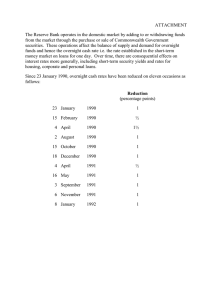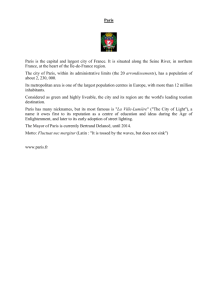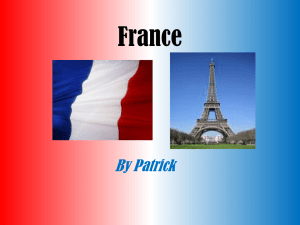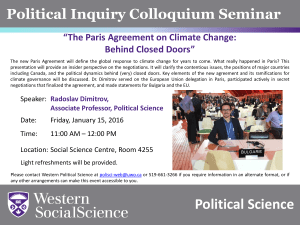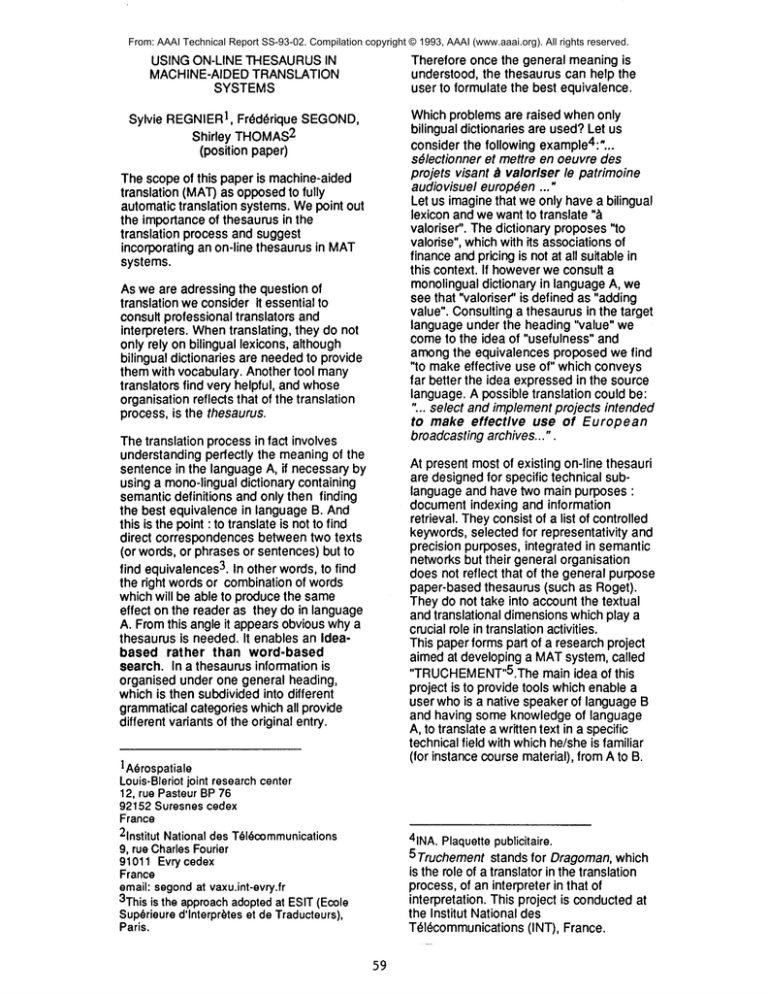
From: AAAI Technical Report SS-93-02. Compilation copyright © 1993, AAAI (www.aaai.org). All rights reserved.
Thereforeoncethe general meaningis
understood,the thesauruscan help the
user to formulatethe best equivalence.
USINGON-LINE THESAURUS
IN
MACHINE-AIDEDTRANSLATION
SYSTEMS
1, Fr(}d6rique SEGOND,
Sylvie REGNIER
2
Shirley THOMAS
(position paper)
Thescopeof this paperis machine-aided
translation (MAT)as opposed
to fully
automatictranslation systems.Wepoint out
the importanceof thesaurusin the
translation processandsuggest
incorporating an on-line thesaurusin MAT
systems.
As weare adressingthe questionof
translationweconsiderit essentialto
consultprofessionaltranslators and
interpreters. When
translating, they do not
only rely on bilingual lexicons,although
bilingual dictionaries are needed
to provide
themwith vocabulary.Anothertool many
translators find veryhelpful, andwhose
organisation
reflects that of the translation
process,is the thesaurus.
Thetranslationprocessin fact involves
understanding
perfectly the meaningof the
sentencein the languageA, if necessaryby
usinga mono-lingualdictionary containing
semanticdefinitions andonly then finding
the best equivalencein languageB. And
this is thepoint: to translateis notto find
direct correspondences
betweentwo texts
(or words,or phrasesor sentences)but
3. In other words,to find
find equivalences
the right wordsor combinationof words
whichwill be able to producethe same
effect on the readeras they do in language
A. Fromthis angleit appearsobviouswhya
thesaurusis needed.It enablesan ideabased rather than word-based
search.In a thesaurusinformationis
organisedunder one general heading,
whichis then subdividedinto different
grammatical
categorieswhichall provide
differentvariantsof the original entry.
! A6rospatiale
Louis-Bleriot
joint research
center
12, rue PasteurBP76
92152Suresnescedex
France
21nstitut NationaldesT61dcommunications
9, rueCharles
Fourier
91011Evry cedex
France
email:segond
at vaxu.int-evry.fr
3Thisis the approach
adopted
at ESIT(Ecole
Sup6rieure
d’lnterpr~teset deTraducteurs),
Paris.
59
Whichproblemsare raised whenonly
bilingual dictionaries are used?Let us
considerthe following example4:"...
sdlectionner et mettre en oeuvredes
projets visant ~ valoriser le patrimoine
audiovisueleuropden..."
Let us imaginethat weonly havea bilingual
lexiconandwewantto translate",~
valoriser". Thedictionary proposes
"to
valorise", whichwith its associations
of
financeandpricingis not at all suitablein
this context. If however
weconsulta
monolingualdictionary in languageA, we
seethat "valoriser" is definedas "adding
value". Consultinga thesaurusin the target
languageunder the heading"value" we
cometo the idea of "usefulness"and
amongthe equivalencesproposedwe find
"to makeeffective use of" whichconveys
far better the idea expressed
in the source
language.A possibletranslation could be:
"... select andimplement
projects intended
to make effective use of European
broadcastingarchives...".
At presentmostof existing on-line thesauri
are designed
for specific technical sublanguageand havetwo mainpurposes:
documentindexing and information
retrieval. Theyconsistof a list of controlled
keywords,
selectedfor representativity and
precision purposes,integrated in semantic
networksbut their generalorganisation
doesnot reflect that of the generalpurpose
paper-basedthesaurus(such as Roget).
Theydo not take into accountthe textual
andtranslational dimensions
whichplay a
crucialrole in translationactivities.
This paperformspart of a researchproject
aimedat developinga MATsystem,called
"TRUCHEMENT"5.The
main idea of this
project is to providetools whichenablea
user whois a native speakerof languageB
and having someknowledgeof language
A, to translatea writtentext in a specific
technicalfield with whichhe/sheis familiar
(for instancecoursematerial),fromA to
41NA.
Plaquette
publicitaire.
5 Truchementstands for Dragoman,
which
is the role of a translatorin thetranslation
process,of an interpreterin that of
interpretation. This project is conducted
at
the Institut Nationaldes
T(~l~communications
(INT), France.
Blbliographle
LISTEAD
J.-L. "Specifications for thesaurus
software", Informationprocessingand
management,
Vol. 27, Nos2/3, pp. 165175, 1991.
AITCHISON
J., GILCHRIST
A., "Construire
un thdsaurus- Manuelpratique", ADBS,
Paris, 1992.
LONG
B. "Linguistique et indexation",
Documentaliste,
vol. 17, n°3, mai-juin 1980.
CHANOD
Jean-Pierre, HARRIEHAUSEN
Bettina, MONTEMAGNI
Simonetta, "A twostagealgorithmto parsemulti-lingual
argumentstructures", Proceedings
of the
International conferenceon Currentissues
in Computational
Linguistics, June10-14
1991,Universiti SainsMalaysia,Penang,
Malaysia,pp. 183-197,1991.
Laroussethesaurus, Larousse, 1991.
LEDERERMarianne andSELESKOVITCH
Danica,Interpr~terpourtraduire, Didier
drudition, Paris, 1984.
Machine
TranslationsubmitIII, Washington
DC,July 1-4, 1991.
CHAUMIER
J., "Les languages
documentaires
- le traitementlinguistique
de rinformation documentaire",EME,Paris,
1978.
MALONE
C.L., DISCOLL
R.J., PEPEJ.W.,
"Modelingthe performanceof an
automatedkeywordingsystem",
Information processing and management,
voL 27, Nos2/3, pp. 145-151,1991.
CHAUMIER
J., DEJEAN
M., "L’indexation
documentaire
- de I’analyse conceptuelle
humaine~ ranalyse automatique
morphosyntaxique",Documentaliste,voL
27, n° 6, nov-dec.1990.
MARCHALOT
M.L., "Une exp(~rience de
th(~saurusd’interrogation: & la recherche
d’un outil d’interrogation d’un syst~me
de
documentationautomatique",
Documentaliste,voL19, n°6, nov.-Dec.
1982.
Conference
"Phras(~ologieet terminologie
en traductionet en interpretation",
proceedings, Gen~ve,2-40ctobre 1991.
Merriam- WebsterDictionary, Pocket
books, 1974.
DURIEUX
Christine, Fondement
didactique
de la traductiontechnique,Didier ~rudition,
CollectionTraductologie,n° 3,Paris, 1988.
MONTEMAGNI
Simonetta,
VANDERWENDE
Lucy, "Structural patterns
vs. string patternsfor extractingsemantic
information fromdictionaries", Proceedings
of COLING
92, pp.546-552.
Harrap’s NewstandardFrenchand English
Dictionary, HarrapsLondon,Bordas
diffuseur Paris, 1986.
FourthInternational Conference
on
Theoretical andMethodological
Issue in
MachineTranslation, Proceedings
of the
conference, June25-27, Canada,1992.
REGNIER
Sylvie, CLEMENCIN
Gr~goire,
"Probl~matique
de I’exploitation
automatique
d’une terminologie- cas
d’a~rospatiale", Proceedingsof Avignon
1992, TAMASymposium,pp. 81-97.
JENSEN
Karen, "PEGASUS:
deriving
predicateargument
structures after a
syntactic parse", Presentation
at the
Intemational workshopon parsing
technologies.CarnegieMellonUniversity,
28-31 August 1989.
RIVIERA.,"Construction des langages
d’indexation- Aspectsth(~oriques",
Documentaliste,
vol27, n°6, nov.-d(}c.
1990.
LALLICH-BOIDINGenevieve, HENNERON
Gdrard, PALERMITI
Rosalba, Analyse du
fran~ais. Achdvement
et implantationde
I’analyseur morpho-syntaxique,
Lescahiers
du CRISS,N° 16, Grenoble, Novembre
1990.
LARIVIERE
L., "Vers un produit unifi~ en
terminologieet en documentation
:le
thesaurusterminologique",Meta,XXXlV,3,
pp. 357-467, 1989.
Roget’s Intemationalthesaurus,Collins,
1976.
SEGOND
Fr(}d~rique, JENSEN
Karen, "An
integrated syntactic and semanticsystem
for Natural Language
Understanding",
Proceedingsof COLING
92, pp. 890-895.
Webster’sThird NewInternational
Dictionary, G and C MeriamCo, 1981.
5O


